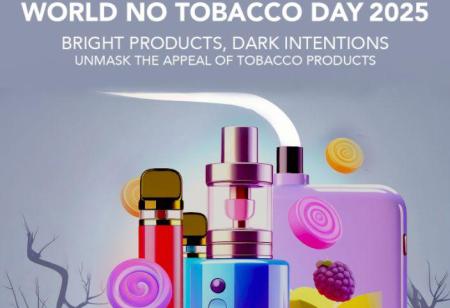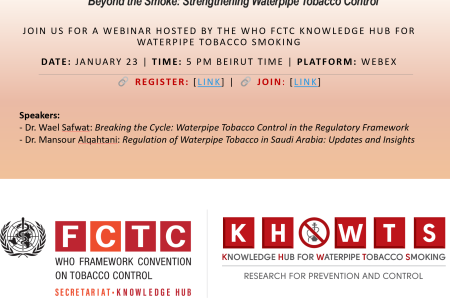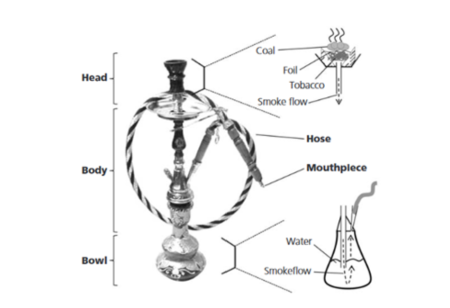
Increased risk of COVID-19 infection amongst smokers and amongst waterpipe users - 13 March 2020

Increased risk of COVID-19 infection amongst smokers and amongst waterpipe users
Background
1- Smoking and increased risk of bacterial and viral infections
Smoking increases the risk of both bacterial and viral infections.
It has been documented that smokers incur a 2- to 4-fold increased risk of invasive pneumococcal lung disease, a disease associated with high mortality. Influenza risk is twofold higher and more severe in smokers compared with nonsmokers.[i] In the case of tuberculosis smokers also have a twofold increased risk of contracting the infection and a 4-fold increased mortality.
The mechanism of increased susceptibility to infections in smokers is multifactorial and includes alteration of the structural and immunologic host defenses.
- Structural changes: Tobacco smoke and many of its components produce structural changes in the respiratory airways. These changes include increased mucosal permeability, impairment of the mucociliary clearance, changes in pathogen adherence, disruption of the respiratory epithelium, and peribronchial inflammation and fibrosis..[ii]
- Immunologic Mechanisms: Smoking weakens the function of body defense immune cells and the production of antibodies in humans and animals.[iii],[iv],[v]
Increased risk of Coronavirus infection amongst smokers
There is still no robust evidence to suggest an increased risk of infection amongst smokers; however, analysis of deaths from coronavirus in China[vi] shows that men are more likely to die than women, something that may be related to the fact that many more Chinese men smoke than women. Among Chinese patients diagnosed with COVID-19 associated pneumonia, the odds of disease progression (including to death) were 14 times higher among people with a history of smoking[vii] compared to those who did not smoke. This was the strongest risk factor among those examined.
2-Use of Waterpipe and risk of infection transmission
Practice of waterpipe use
Waterpipe smoking is usually practiced in groups. The hose is passed from person to person, and the same mouthpiece is usually used by all the participants. Most smoking sessions last 45 to 60 minutes but may also continue for several hours.
Even if the pipe and mouthpiece is only used by one customer at a time, it should be noted that waterpipes and hoses are generally reused by other smoking customers at the same day It is therefore, not surprising, that waterpipe smokers are exposed to microorganisms that may be harmful to health.[viii],[ix][x]
How do the waterpipes get contaminated with infectious microorganisms?
The risk of transmission of infectious microbial agents through smoking waterpipes is high
- If mouth pieces are not used individually the microorganisms can easily pass from mouth to mouth.
- smokers often cough into hoses and moisture in tobacco smoke promotes the survival of microorganisms inside waterpipe hose.
- Furthermore, the use of cold water in the water chamber for a cold airflow may facilitate the survival of viruses and bacteria.
- The spread of infectious diseases could also result from the uncontrolled, manual preparation of narghile.
Evidence of Infectious Disease transmission though waterpipe
Waterpipes and mouthpieces have been implicated in an outbreak of pulmonary tuberculosis in Queensland, Australia.[xi],[xii] .El-Barrawy et al. [xiii] related infection with Helicobacter pylori to waterpipes smoking in Egypt. The risk of transmission of the hepatitis C virus through waterpipes smoking was also demonstrated by Habib et al. (2001).[xiv] Other viruses that can be transmitted are Epstein-Barr virus (EBV), herpes simplex virus and respiratory virus [xv]. Fungal infections have also been reported to be waterpipes transmitted diseases when a patient with acute myeloid leukemia showed invasive infection with Aspergillus sp.[xvi][xvii]
Measures were taken by some countries in view of the potential risk of COVID-19 infection though waterpipe use
Some countries in the Eastern Mediterranean Region such as Iran, Kuwait, Pakistan, Qatar and Saudi Arabia have banned the use of shisha in public places such as cafes, shisha bars or restaurants to avoid COVID-19 transmission.
3- Recommendations
- Inform the public about the high risk of infection of COVID-19 when using waterpipe.
- Complete ban of the use of waterpipes in all public establishments such as cafes, bars, restaurants, etc. with no exceptions even if the mouthpiece or hose is changed with each individual use. Avoid sharing waterpipe mouthpieces even in home settings.
- Ensure the enforcement of the ban with adequate fines and penalties.
- Inform the public about the increased risk of COVID 19 infection in smokers versus non-smokers.
- Encourage smokers to quit smoking.





